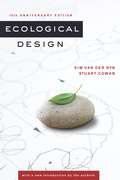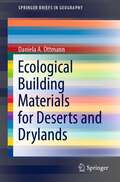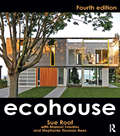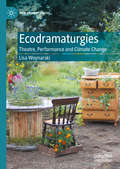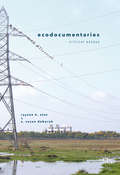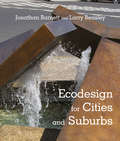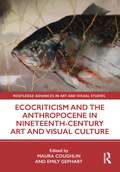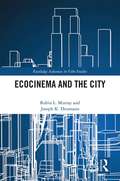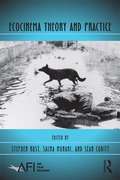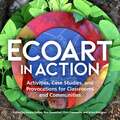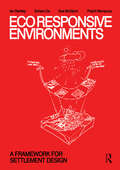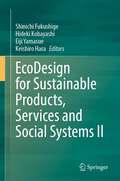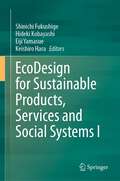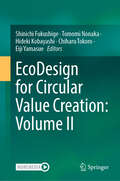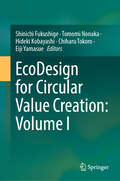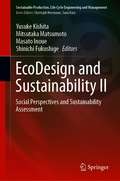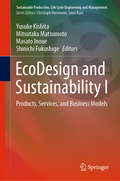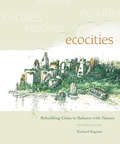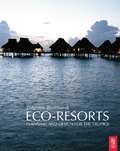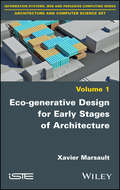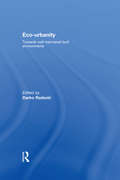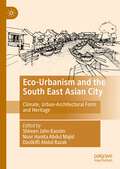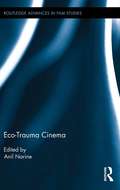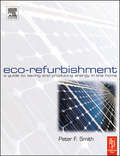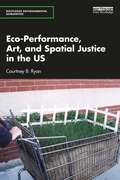- Table View
- List View
Ecological Design, Tenth Anniversary Edition: An Ecological Design Retrospective
by Sim Van der Ryn Stuart CowanEcological Design is a landmark volume that helped usher in an exciting new era in green design and sustainability planning. Since its initial publication in 1996, the book has been critically important in sparking dialogue and triggering collaboration across spatial scales and design professions in pursuit of buildings, products, and landscapes with radically decreased environmental impacts. This 10th anniversary edition makes the work available to a new generation of practitioners and thinkers concerned with moving our society onto a more sustainable path. Using examples from architecture, industrial ecology, sustainable agriculture, ecological wastewater treatment, and many other fields, Ecological Design provides a framework for integrating human design with living systems. Drawing on complex systems, ecology, and early examples of green building and design, the book challenges us to go further, creating buildings, infrastructures, and landscapes that are truly restorative rather than merely diminishing the rate at which things are getting worse.
Ecological Building Materials for Deserts and Drylands (SpringerBriefs in Geography)
by Daniela A. OttmannThis book examines prospective climate adaptive building materials in desert and drylands in the context of climate change, desertification, urbanisation demands, and the consequent sustainable urban development challenges. This preliminary collection of ecological materials covers the characterisation of biotic and abiotic resources for materials, their specifications and benefits for adequate bio-climatic design and construction. Particular emphasis is given to ecological composite materials for advances in desert architecture. Based on the initial collection, the book culminates with potentials for new ecological building materials. The "eComposite Combinator" matrix offers potential research recipes and encourages the reader to conduct further climate-matters related research.
Ecohouse
by Sue Roaf Manuel Fuentes Stephanie Thomas-ReesSue Roaf is famed for her approach to design and her awareness of energy efficiency. Here she reveals the concepts, structures and techniques that lie behind the realization of her ideals. By using her own house as a case study, Roaf guides the reader through the ideas for energy-efficient design or 'eco-design'. Now in its fourth edition, the bestselling Ecohouse continues to be both a technical guide and an inspiration for thousands of architects, designers and eco-builders all over the world. Ecohouse provides design information about the latest low-impact materials and technologies, showcasing the newest and best ‘green’ solutions. Revised and updated, this edition also includes new case studies inspiring readers with more real-life examples of how to make an ecohouse work.
Ecodramaturgies: Theatre, Performance and Climate Change (New Dramaturgies)
by Lisa WoynarskiThis book addresses theatre’s contribution to the way we think about ecology, our relationship to the environment, and what it means to be human in the context of climate change. It offers a detailed study of the ways in which contemporary performance has critiqued and re-imagined everyday ecological relationships, in more just and equitable ways. The broad spectrum of ecologically-oriented theatre and performance included here, largely from the UK, US, Canada, Europe, and Mexico, have problematised, reframed, and upended the pervasive and reductive images of climate change that tend to dominate the ecological imagination. Taking an inclusive approach this book foregrounds marginalised perspectives and the multiple social and political forces that shape climate change and related ecological crises, framing understandings of the earth as home. Recent works by Fevered Sleep, Rimini Protokoll, Violeta Luna, Deke Weaver, Metis Arts, Lucy + Jorge Orta, as well as Indigenous activist movements such as NoDAPL and Idle No More, are described in detail.
Ecodocumentaries
by Rayson K. Alex S. Susan DeborahThis book features ten critical essays on ecodocumentaries written by eminent scholars from India, USA, Ireland, Finland and Turkey in the area of ecocinema studies. Situating social documentaries with explicit ecological form and content, the volume takes relational positions on political, cultural and conservational aspects of natures and cultures in various cultural contexts. Documentaries themed around issues such as electronic waste, animal rights, land ethics, pollution of river, land grabbing, development and exotic plants are some of the topics ecocritiqued in this volume.
Ecodesign for Cities and Suburbs
by Jonathan Barnett Larry BeasleyAs world population grows, and more people move to cities and suburbs, they place greater stress on the operating system of our whole planet. But urbanization and increasing densities also present our best opportunity for improving sustainability, by transforming urban development into desirable, lower-carbon, compact and walkable communities and business centers. Jonathan Barnett and Larry Beasley seek to demonstrate that a sustainable built and natural environment can be achieved through ecodesign, which integrates the practice of planning and urban design with environmental conservation, through normal business practices and the kinds of capital programs and regulations already in use in most communities. Ecodesign helps adapt the design of our built environment to both a changing climate and a rapidly growing world, creating more desirable places in the process. In six comprehensively illustrated chapters, the authors explain ecodesign concepts, including the importance of preserving and restoring natural systems while also adapting to climate change; minimizing congestion on highways and at airports by making development more compact, and by making it easier to walk, cycle and take trains and mass transit; crafting and managing regulations to insure better placemaking and fulfill consumer preferences, while incentivizing preferred practices; creating an inviting and environmentally responsible public realm from parks to streets to forgotten spaces; and finally how to implement these ecodesign concepts. Throughout the book, the ecodesign framework is demonstrated by innovative practices that are already underway or have been accomplished in many cities and suburbs--from Hammarby Sjöstad in Stockholm to False Creek North in Vancouver to Battery Park City in Manhattan, as well as many smaller-scale examples that can be adopted in any community. Ecodesign thinking is relevant to anyone who has a part in shaping or influencing the future of cities and suburbs - designers, public officials, and politicians.
Ecocriticism and the Anthropocene in Nineteenth-Century Art and Visual Culture (Routledge Advances in Art and Visual Studies)
by Maura CoughlinIn this volume, emerging and established scholars bring ethical and political concerns for the environment, nonhuman animals and social justice to the study of nineteenth-century visual culture. They draw their theoretical inspiration from the vitality of emerging critical discourses, such as new materialism, ecofeminism, critical animal studies, food studies, object-oriented ontology and affect theory. This timely volume looks back at the early decades of the Anthropocene to query the agency of visual culture to critique, create and maintain more resilient and biologically diverse local and global ecologies.
Ecocinema in the City (Routledge Advances in Film Studies)
by Robin L. Murray Joseph K. HeumannIn Ecocinema in the City, Murray and Heumann argue that urban ecocinema both reveals and critiques visions of urban environmentalism. The book emphasizes the increasingly transformative power of nature in urban settings, explored in both documentaries and fictional films such as Children Underground, White Dog, Hatari! and Lives Worth Living. The first two sections—"Evolutionary Myths Under the City" and "Urban Eco-trauma"—take more traditional ecocinema approaches and emphasize the city as a dangerous constructed space. The last two sections—"Urban Nature and Interdependence" and "The Sustainable City"—however, bring to life the vibrant relationships between human and nonhuman nature. Ecocinema in the City provides a space to explore these relationships, revealing how ecocinema shows that both human and nonhuman nature can interact sustainably and thrive.
Ecocinema Theory and Practice (AFI Film Readers)
by Sean Cubitt Stephen Rust Salma MonaniEcocinema Theory and Practice is the first collection of its kind—an anthology that offers a comprehensive introduction to the rapidly growing field of eco-film criticism, a branch of critical scholarship that investigates cinema’s intersections with environmental understandings. It references seminal readings through cutting edge research and is designed as an introduction to the field as well as a sourcebook. It defines ecocinema studies, sketches its development over the past twenty years, provides theoretical frameworks for moving forward, and presents eloquent examples of the practice of eco-film criticism through essays written by the field’s leading and emerging scholars. From explicitly environmental films such as Werner Herzong's Grizzly Man and Roland Emmerich's The Day After Tomorrow to less obvious examples like Errol Morris's Fast, Cheap & Out of Control and Christopher Nolan's Inception, the pieces in this collection comprehensively interrogate the breadth of ecocinema. Ecocinema Theory and Practice also directs readers to further study through lists of recommended readings, professional organizations, and relevant periodicals.
Ecoart in Action: Activities, Case Studies, and Provocations for Classrooms and Communities
by Amara Geffen, Ann Rosenthal, Chris Fremantle, and Aviva RahmaniReady-to-go, vetted approaches for facilitating artistic environmental projectsHow do we educate those who feel an urgency to address our environmental and social challenges? What ethical concerns do art-makers face who are committed to a deep green agenda? How can we refocus education to emphasize integrative thinking and inspire hope? What role might art play in actualizing environmental resilience?Compiled from 67 members of the Ecoart Network, a group of more than 200 internationally established practitioners, Ecoart in Action stands as a field guide that offers practical solutions to critical environmental challenges. Organized into three sections—Activities, Case Studies, and Provocations—each contribution provides models for ecoart practice that are adaptable for use within a variety of classrooms, communities, and contexts. Educators developing project and place-based learning curricula, citizens, policymakers, scientists, land managers, and those who work with communities (human and other) will find inspiration for integrating art, science, and community-engaged practices into on-the-ground environmental projects. If you share a concern for the environmental crisis and believe art can provide new options, this book is for you!
EcoResponsive Environments: A Framework for Settlement Design
by Ian Bentley Sue McGlynn Soham De Prachi RampuriaEcoResponsive Environments integrates our current knowledge of designing for human needs, with a deeper understanding of natural systems. The book offers both a call to action and a comprehensive yet pragmatic framework for practising the art and science of settlement design, called EcoResponsive Design.Bridging the gap between theory and generic policy on the one hand, and design for specific places and sites on the other, the book is aimed not only at the professionals involved in planning, designing and developing these places, but also the wider range of communities interested in creating better spaces for our everyday lives.EcoResponsive Design encompasses all scales, ranging from the overall form of settlements and the landscapes in which they sit, to buildings and the detailed design of public spaces. Drawing from projects, places and best practices in many different countries and contexts across the world, it demonstrates how positive changes at the local scale can be achieved for every single site, large or small. The book urges a shift in focus from individual specialisms to collaborative actions, enabling development stakeholders to negotiate a balance between short-term financial viability and longer-term environmental and social values.
EcoDesign for Sustainable Products, Services and Social Systems II
by Shinichi Fukushige Hideki Kobayashi Eiji Yamasue Keishiro HaraThis 2-volume book highlights cutting-edge ecodesign research and covers broad areas ranging from individual product and service design to social system design. It includes business and policy design, circular production, life cycle design and management, digitalization for sustainable manufacturing, user behavior and health, ecodesign of social infrastructure, sustainability education, sustainability indicators, and energy system design. Featuring selected papers presented at EcoDesign 2021: 12th International Symposium on Environmentally Conscious Design and Inverse Manufacturing, it also includes diverse, interdisciplinary approaches to foster ecodesign research and activities. In the context of Sustainable Development Goals (SDGs), in particular SDG 12 (Responsible Consumption and Production), it addresses design innovations for sustainable value creation, considering technological developments, legislation, and consumer lifestyles. Further, the book discusses the conceptof circular economy, which aims to develop circular business models for resource efficient society by taking advantage of digital technologies including artificial intelligence, internet of things, digital twin, data analysis and simulation. Written by experts from academia and industry, Volume 2 focuses on the sustainability assessment of product lifecycle, waste management, material circularity and energy efficiency, food and agriculture, user behavior and health, and transportation. The methods, tools, and practices described are useful for readers to facilitate value creation for sustainability.
EcoDesign for Sustainable Products, Services and Social Systems I
by Shinichi Fukushige Hideki Kobayashi Eiji Yamasue Keishiro HaraThis 2-volume book highlights cutting-edge ecodesign research and covers broad areas ranging from individual product and service design to social system design. It includes business and policy design, circular production, life cycle design and management, digitalization for sustainable manufacturing, user behavior and health, ecodesign of social infrastructure, sustainability education, sustainability indicators, and energy system design. Featuring selected papers presented at EcoDesign 2021: 12th International Symposium on Environmentally Conscious Design and Inverse Manufacturing, it also includes diverse, interdisciplinary approaches to foster ecodesign research and activities. In the context of Sustainable Development Goals (SDGs), in particular SDG 12 (Responsible Consumption and Production), it addresses design innovations for sustainable value creation, considering technological developments, legislation, and consumer lifestyles. Further, the book discusses the concept of circular economy, which aims to develop circular business models for resource efficient society by taking advantage of digital technologies including artificial intelligence, internet of things, digital twin, data analysis and simulation. Written by experts from academia and industry, Volume 1 highlights sustainable design such as product and process design, collaborative design, sustainable innovation, digital technologies, design methodology for sustainability, and energy system design. The methods, tools, and practices described are useful for readers to facilitate value creation for sustainability.
EcoDesign for Circular Value Creation: Volume II
by Shinichi Fukushige Tomomi Nonaka Hideki Kobayashi Eiji Yamasue Chiharu TokoroThis 2-volume book highlights cutting-edge ecodesign research, encompassing product and service design, smart manufacturing, and social perspectives. Featuring selected papers from EcoDesign 2023: 13th International Symposium on Environmentally Conscious Design and Inverse Manufacturing, it offers interdisciplinary approaches to foster sustainable innovations. Within the framework of the Sustainable Development Goals (SDGs), it underscores the necessity for the manufacturing sector to innovate for sustainable value creation, taking into account technological advancements, regulatory requirements, and consumer behavior. Additionally, it explores the concept of the circular economy, which originated in Europe and seeks to enhance resource efficiency by transitioning from a linear to a circular economic model. This book aims to unite professionals across the globe who are dedicated to advancing the field of ecodesign, and facilitating the exchange of knowledge across various disciplines and communities. The second volume highlights sustainable technology, social perspectives in ecodesign, and business strategy. The chapters cover digital and AI technologies for sustainability, sustainable social infrastructure, smart manufacturing, sustainable consumption and production, policy, legislation and social activities, finance and investment for sustainability, green business, and engineering economics. Readers will discover diverse perspectives from expert contributors who delve into critical issues like climate change education in primary schools in Vietnam; food security in Japan; repurposing lithium-ion batteries; carbon neutrality through sensor-based smart city services; life cycle assessments of automotive parts; human health risks from chemicals in export products; and developing high-resolution spatial global biodiversity damage factors. This collection invites readers to think through critical questions about resource efficiency and the shift from a linear to a circular economy. Researchers in the fields of sustainable design, environmental engineering, policy-making, and business strategy will find this book invaluable.
EcoDesign for Circular Value Creation: Volume I
by Shinichi Fukushige Tomomi Nonaka Hideki Kobayashi Eiji Yamasue Chiharu TokoroThis 2-volume book sheds new light on the forefront of ecodesign research, encompassing product and service design, smart manufacturing, and social perspectives. Featuring selected papers from EcoDesign 2023: 13th International Symposium on Environmentally Conscious Design and Inverse Manufacturing, it offers interdisciplinary approaches to foster sustainable innovations. Within the framework of the Sustainable Development Goals (SDGs), it underscores the necessity for the manufacturing sector to innovate for sustainable value creation, taking into account technological advancements, regulatory requirements, and consumer behavior. Additionally, it explores the concept of the circular economy, which originated in Europe and seeks to enhance resource efficiency by transitioning from a linear to a circular economic model. This book aims to unite professionals across the globe who are dedicated to advancing the field of ecodesign, and facilitating the exchange of knowledge across various disciplines and communities. The first volume highlights the product life cycle design and management, sustainability assessment for ecoDesign, and circular economy. Readers will delve into the environmentally conscious design of products and services, life cycle management, sustainable manufacturing, EoL management and process technologies, green supply chain management, life cycle evaluation, and sustainability indices. Contributions from renowned scholars provide critical insights into ecodesign regulations compliance processes like EPD certifications; consumer behavior towards eco-labels; innovative business models for sustainability; participatory approaches for ESG initiatives; digital twins for real-time life cycle assessment; AI techniques supporting wastewater treatment; among others.
EcoDesign and Sustainability II: Social Perspectives and Sustainability Assessment (Sustainable Production, Life Cycle Engineering and Management)
by Mitsutaka Matsumoto Shinichi Fukushige Yusuke Kishita Masato InoueThis book highlights cutting-edge ecodesign research, covering product and service design, smart manufacturing, and social perspectives in ecodesign. Featuring selected papers presented at EcoDesign 2019: 11th International Symposium on Environmentally Conscious Design and Inverse Manufacturing, it also includes diverse, interdisciplinary approaches to foster ecodesign research and activities. In the context of Sustainable Development Goals (SDGs), it addresses the need for the manufacturing industry to design innovations for sustainable value creation, taking into account technological developments, legislation, and consumer lifestyles. Further, the book discusses the concept of circular economy, which originated in Europe and aims to increase resource efficiency by shifting away from the linear economy.Focusing on product life cycle design and management, smart manufacturing, circular economy, and business strategies, and providing useful approaches and solutions to these emerging concepts, this book is intended for both researchers and practitioners working in the broad field of ecodesign and sustainability.
EcoDesign and Sustainability I: Products, Services, and Business Models (Sustainable Production, Life Cycle Engineering and Management)
by Mitsutaka Matsumoto Shinichi Fukushige Yusuke Kishita Masato InoueThis book highlights cutting-edge ecodesign research, covering product and service design, smart manufacturing, and social perspectives in ecodesign. Featuring selected papers presented at EcoDesign 2019: 11th International Symposium on Environmentally Conscious Design and Inverse Manufacturing, it also includes diverse, interdisciplinary approaches to foster ecodesign research and activities. In the context of Sustainable Development Goals (SDGs), it addresses the need for the manufacturing industry to design innovations for sustainable value creation, taking into account technological developments, legislation, and consumer lifestyles. Further, the book discusses the concept of circular economy, which originated in Europe and aims to increase resource efficiency by shifting away from the linear economy. Focusing on product life cycle design and management, smart manufacturing, circular economy, and business strategies, and providing useful approaches and solutions to these emerging concepts, this book is intended for both researchers and practitioners working in the broad field of ecodesign and sustainability.
EcoCities
by Richard RegisterMost of the world's population now lives in cities. So if we are to address the problems of environmental deterioration and peak oil adequately, the city has to be a major focus of attention.Ecocities is about re-building cities and towns based on ecological principles for the long term sustainability, cultural vitality and health of the Earth's biosphere. Unique in the literature is the book's insight that the form of the city really matters - and that it is within our ability to change it, and crucial that we do. Further, that the ecocity within its bioregion is comprehensible and do-able, and can produce a healthy and potentially happy future.Ecocities describes the place of the city in evolution, nature and history. It pays special attention to the key question of accessibility and transportation, and outlines design principles for the ecocity. The reader is encouraged to plunge in to its economics and politics: the kinds of businesses, planning and leadership required. The book then outlines the tools by which a gradual transition to the ecocity could be accomplished. Throughout, this new edition is generously illustrated with the author's own inspired visions of what such rebuilt cities might actually look like.Richard Register is one of the world's great theorists and authors in ecological city design and planning. The founder of Urban Ecology and Ecocity Builders, he convened the first International Ecocity Conference in 1990, lectures around the world, and has authored two previous books, as well as an earlier edition of Ecocities.
Eco-resorts
by Zbigniew BromberekEco-Resorts is a design guide for low impact, environmentally friendly tourist resorts in the tropics. The book is the first to offer architects practical, detailed guidance in developing resort buildings that work with a tropical climate andmeet the needs and expectations of the client and building inhabitants. The book includes both architectural design and material solutions, supported by theoretical principles, to present asustainable approach to resort design. It demonstrates that tropical resort buildings do not necessarily require largeenergy input, in compliance with green building standards. Case studies show how principles of sustainable designhave been successfully applied in tropical environments. * Written by an industry insider with practical design experience, knowledge and expertise.* Demonstrates design practices related to site planning and layout, and re-assesses best practices for a tropicalenvironment, allowing architects to apply design principles to their own projects.* Includes international case studies from several countries to illustrate best practice from a variety of tropical climate destinations around the world. Z (Zbigniew) Bromberek, PhD, is an architect educated and registered in Poland, and postgraduate-educated and residing in Australia. Z has been practising and teaching architecture for nearly 30 years. He has been involved and associated with various educational institutions and professional organizations in a number of countries around the world. Before the current appointment as Senior Lecturer in Architecture at the University of Tasmania, Z spent three years as Lecturer in Environmental Design at the University of Queensland, and two years as Guest Professor in Architectural Design in Nanjing, PR China. He was also the President of the Architectural Science Association ANZAScA for three consecutive terms in 2000–05. Z’s major research interests include design–environment interaction, low-impact architecture and re-integration of architecture as an expression of a multi-disciplinary approach to design.
Eco-generative Design for Early Stages of Architecture
by Xavier MarsaultThis book can be first considered as a complete synthesis of the EcCoGen ANR project (2011-2012), involving researchers from different French labs (including MAP) and domains, breaking major difficulties of the real-time generative design in the early stages of a pre-architectural project. Then the scope becomes larger, and the authors introduce major prospects following recent advances on natural and artificial evolution.
Eco-Urbanity: Towards Well-Mannered Built Environments
by Darko RadoviThere is need for change in our currently unsustainable cities. Carefully outlining paths towards better, sustainable ways of urban living, this book proposes a radical change in the ways we conceive and live our urban environments. Bringing together diverse cultural and disciplinary views on urban sustainability, eighteen leading academics and practitioners in sustainable architecture and urbanism explore global concerns of sustainability and urbanity. This broad range of issues are clearly articulated and linked to concrete places and projects, merging research and cutting-edge design investigations to promote environmentally and culturally sensitive urban futures.
Eco-Urbanism and the South East Asian City: Climate, Urban-Architectural Form and Heritage
by Shireen Jahn Kassim Noor Hanita Abdul Majid Dzulkifli Abdul RazakThis book traces the history of urban design in tropical South East Asia with a view to offering solutions to contemporary architectural and urban problems. The book examines how pre-colonial forms and patterns from South East Asian traditional cities, overlaid by centuries of change, recall present notions of ecological and organic urbanism. These may look disorganised, yet they reflect and suggest certain common patterns that inform eco-urban design paradigms for the development of future cities.Taking a thematic approach, the book examines how such historical findings, debates and discussions can assist designers and policy makers to interpret and then instil identities in urban design across the Asian region. The book weaves a discourse across planning, urban design, architecture and ornamentation dimensions to reconstruct forgotten forms that align with the climate of place and resynchronise with the natural world, unearthing an ecologically benign urbanism that can inform the future.Written in an accessible style, this book will be an invaluable reference for researchers and students within the fields of cultural geography, urban studies and architecture.
Eco-Trauma Cinema (Routledge Advances in Film Studies)
by Anil NarineFilm has taken a powerful position alongside the global environmental movement, from didactic documentaries to the fantasy pleasures of commercial franchises. This book investigates in particular film’s complex role in representing ecological traumas. Eco-trauma cinema represents the harm we, as humans, inflict upon our natural surroundings, or the injuries we sustain from nature in its unforgiving iterations. The term encompasses both circumstances because these seemingly distinct instances of ecological harm are often related, and even symbiotic: the traumas we perpetuate in an ecosystem through pollution and unsustainable resource management inevitably return to harm us. Contributors to this volume engage with eco-trauma cinema in its three general forms: accounts of people who are traumatized by the natural world, narratives that represent people or social processes which traumatize the environment or its species, and stories that depict the aftermath of ecological catastrophe. The films they examine represent a central challenge of our age: to overcome our disavowal of environmental crises, to reflect on the unsavoury forces reshaping the planet's ecosystems, and to restructure the mechanisms responsible for the state of the earth.
Eco-Refurbishment
by Peter SmithThis clear and accessible guide provides a comprehensive outline on how to convert your house into a more 'green' home. Buildings are the greates energy wasters and for those of us concerned about the environment, and household bills, this book presents the key design changes that we can implement to our own homes to remedy energy loss.This title covers the full range of design chanegs that are available to the homeowner and designer for renovation, from the roof to the basement, from insulation to windows. It also feature a selection of case studies illustrating the experiences of other homeowners and designers and how they have adapted and used the technology available to them in creating an energy efficient home. This is a practical, hands-on guide, ideal for architects, designers and homeowners.
Eco-Performance, Art, and Spatial Justice in the US (Routledge Environmental Humanities)
by Courtney B. RyanIn Eco-Performance, Art, and Spatial Justice in the US, Courtney B. Ryan traces how urban artists in the US from the 1970s until today contend with environmental domestication and spatial injustice through performance. In theater, art, film, and digital media, the artists featured in this book perform everyday, spatialized micro-acts to contest the mutual containment of urbanites and nonhuman nature. Whether it is plant artist Vaughn Bell going for a city stroll in her personal biosphere, photographer Naima Green photographing Black urbanites in lush New York City parks, guerrilla gardeners launching seed bombs into abandoned city lots, or a satirical tweeter parodying BP’s response to the 2010 Deepwater Horizon oil spill, the subjects in this book challenge deeply engrained Western directives to domesticate nonhuman nature. In examining how urban eco-artists perform alternate ecologies that celebrate the interconnectedness of marginalized human, vegetal, and aquatic life, Ryan suggests that small environmental performances can expose spatial injustice and increase spatial mobility. Bringing a performance perspective to the environmental humanities, this interdisciplinary text offers readers stymied by the global climate crisis a way forward. It will appeal to a wide range of students and academics in performance, media studies, urban geography, and environmental studies.
